Abstract
The crystal structure of rat liver 6-pyruvoyl tetrahydropterin synthase has been solved by multiple isomorphous replacement and refined to a crystallographic R-factor of 20.4% at 2.3 A resolution. 6-Pyruvoyl tetrahydrobiopterin synthase catalyses the conversion of dihydroneopterin triphosphate to 6-pyruvoyl tetrahydropterin, the second of three enzymatic steps in the synthesis of tetrahydrobiopterin from GTP. The functional enzyme is a hexamer of identical subunits. The 6-pyruvoyl tetrahydropterin synthase monomer folds into a sequential, four-stranded, antiparallel beta-sheet with a 25 residue, helix-containing insertion between strands 1 and 2 at the bottom of the molecule, and a segment between strands 2 and 3 forming a pair of antiparallel helices, layered on one side of the beta-sheet. Three 6-pyruvoyl tetrahydropterin synthase monomers form an unusual 12-stranded antiparallel beta-barrel by tight association between the N- and C-terminal beta-strands of two adjacent subunits. The barrel encloses a highly basic pore of 6-12 A diameter. Two trimers associate in a head-to-head fashion to form the active enzyme complex. The substrate-binding site is located close to the trimer-trimer interface and comprises residues from three monomers: A, A' and B. A metal-binding site in the substrate-binding pocket is formed by the three histidine residues 23, 48 and 50 from one 6-pyruvoyl tetrahydropterin synthase subunit. Close to the metal, but apparently not liganding it, are residues Cys42, Glu133 (both from A) and His89 (from B), which might serve as proton donors and acceptors during catalysis.
Full text
PDF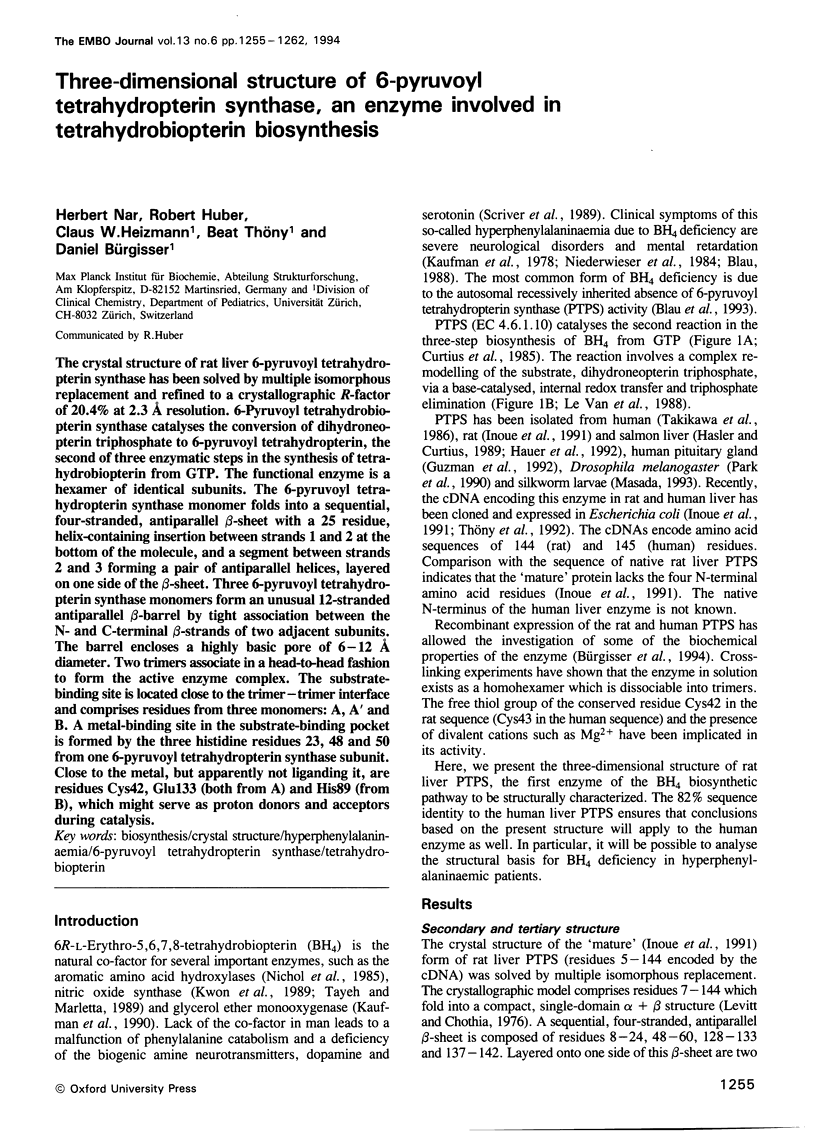
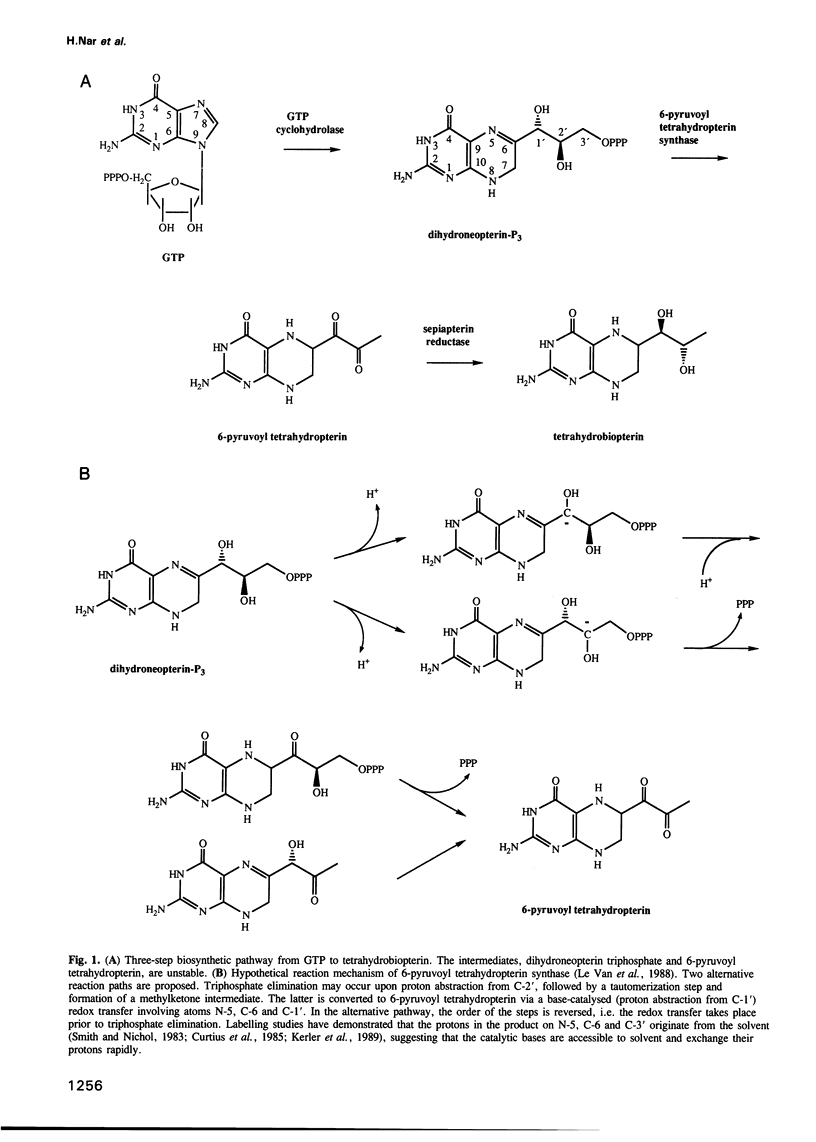
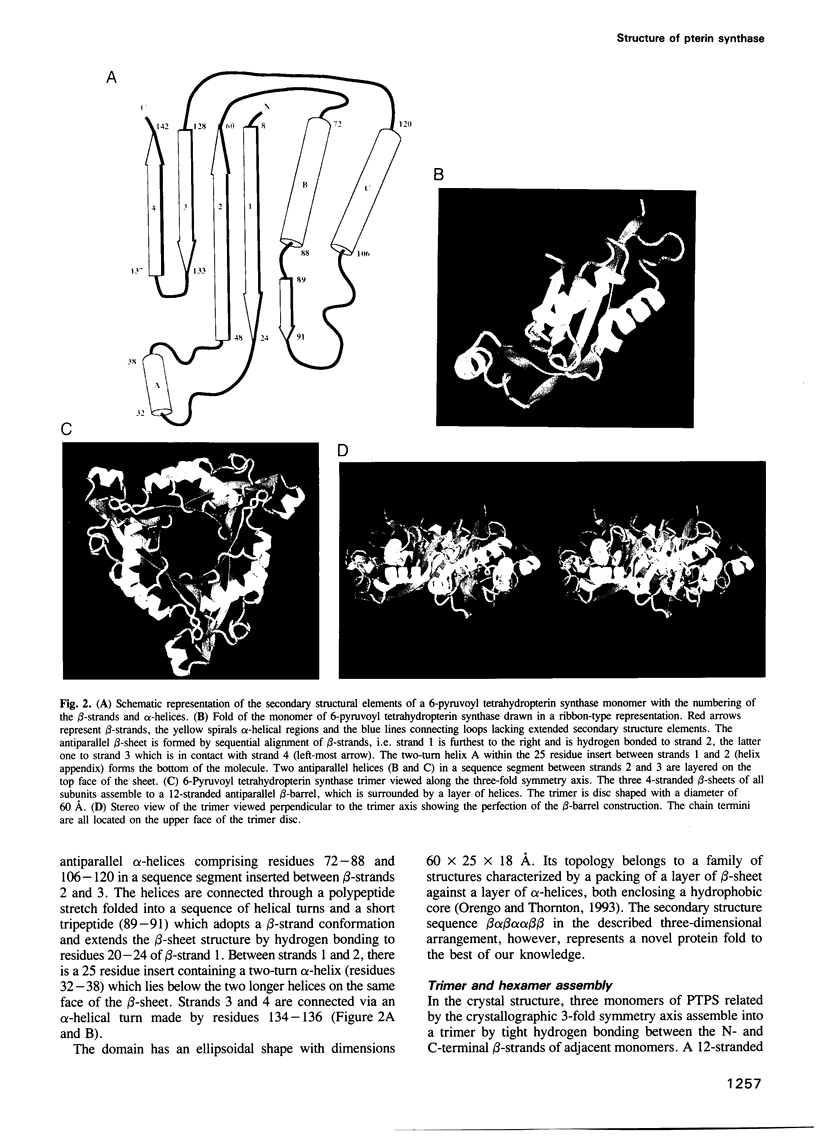
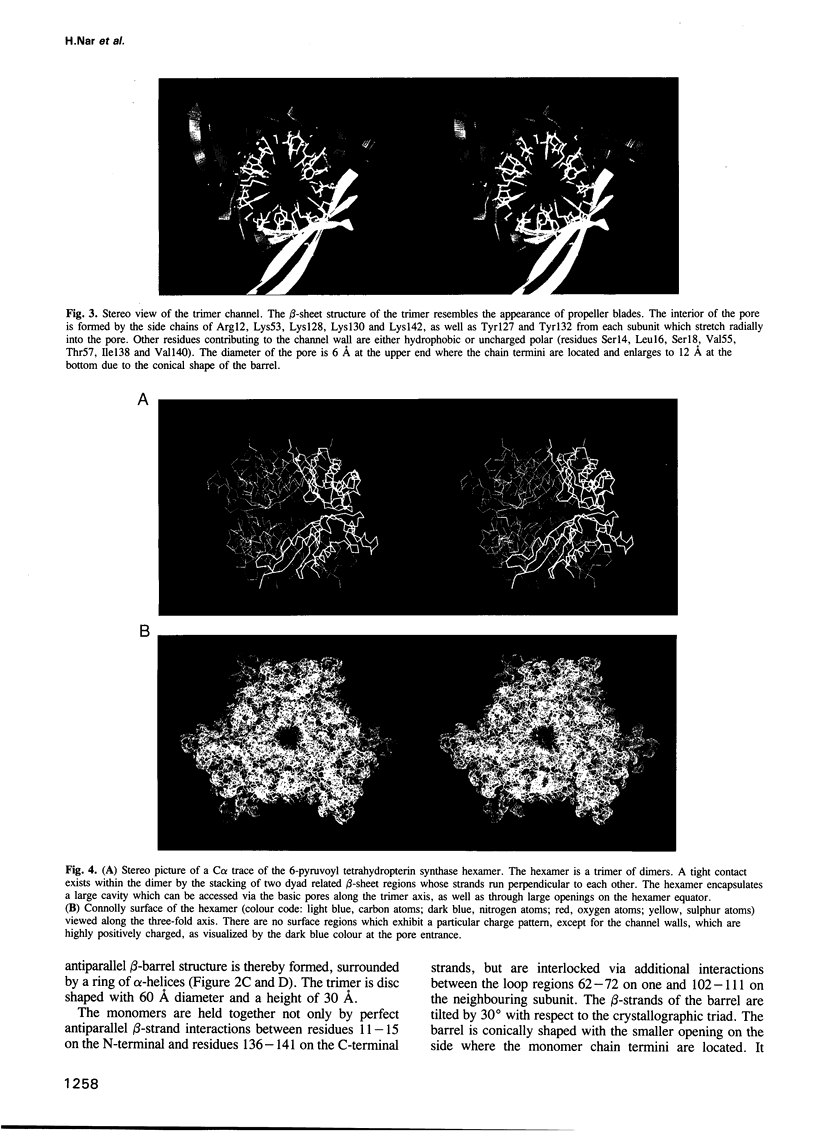
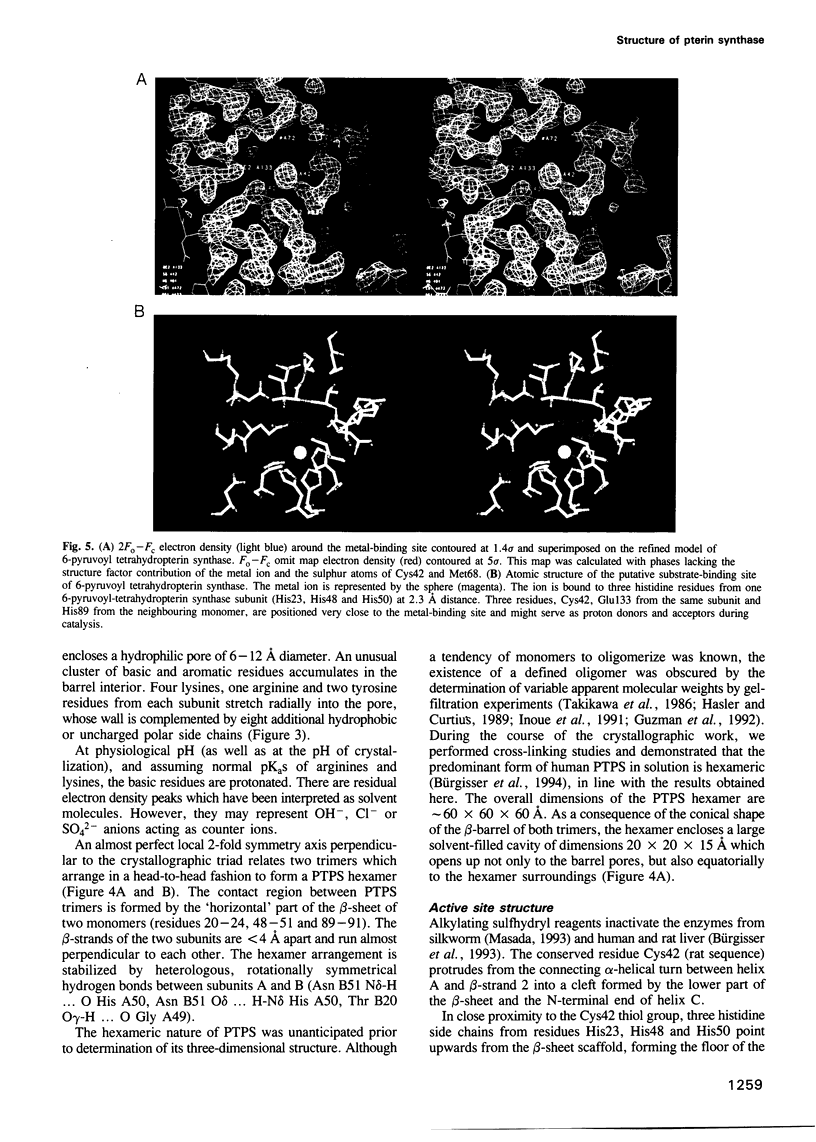
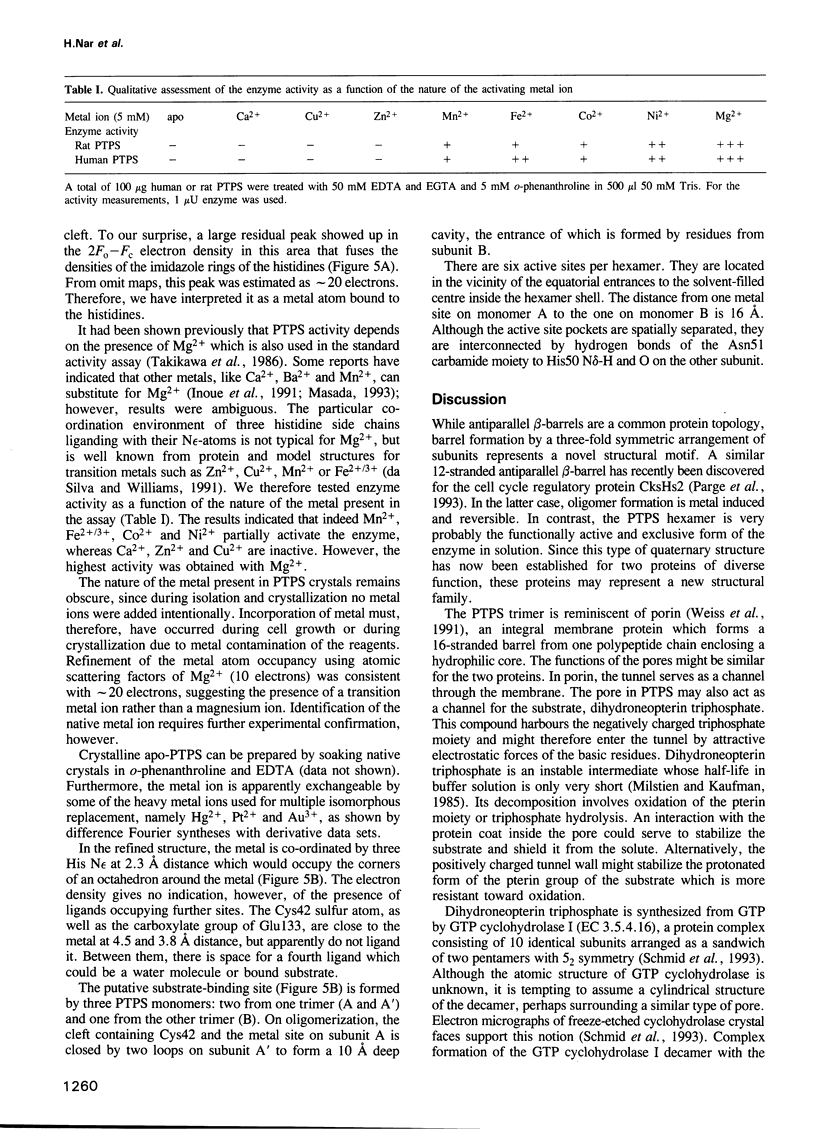
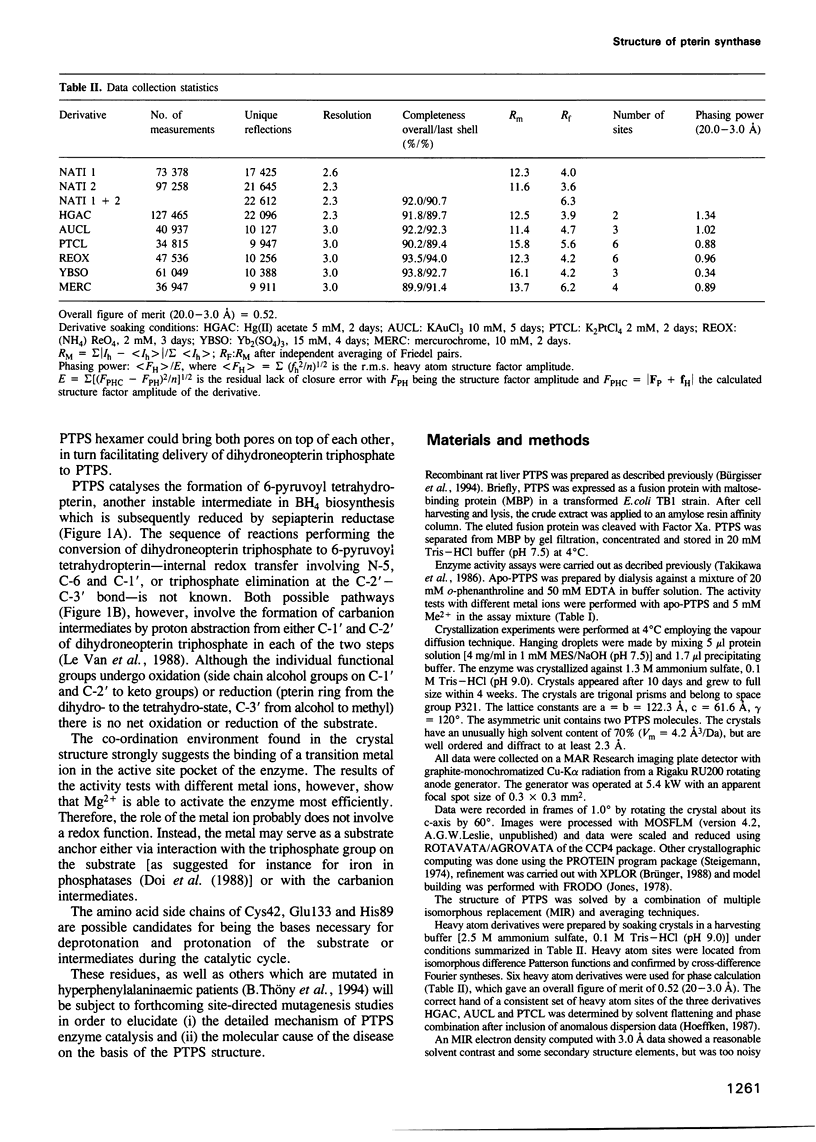
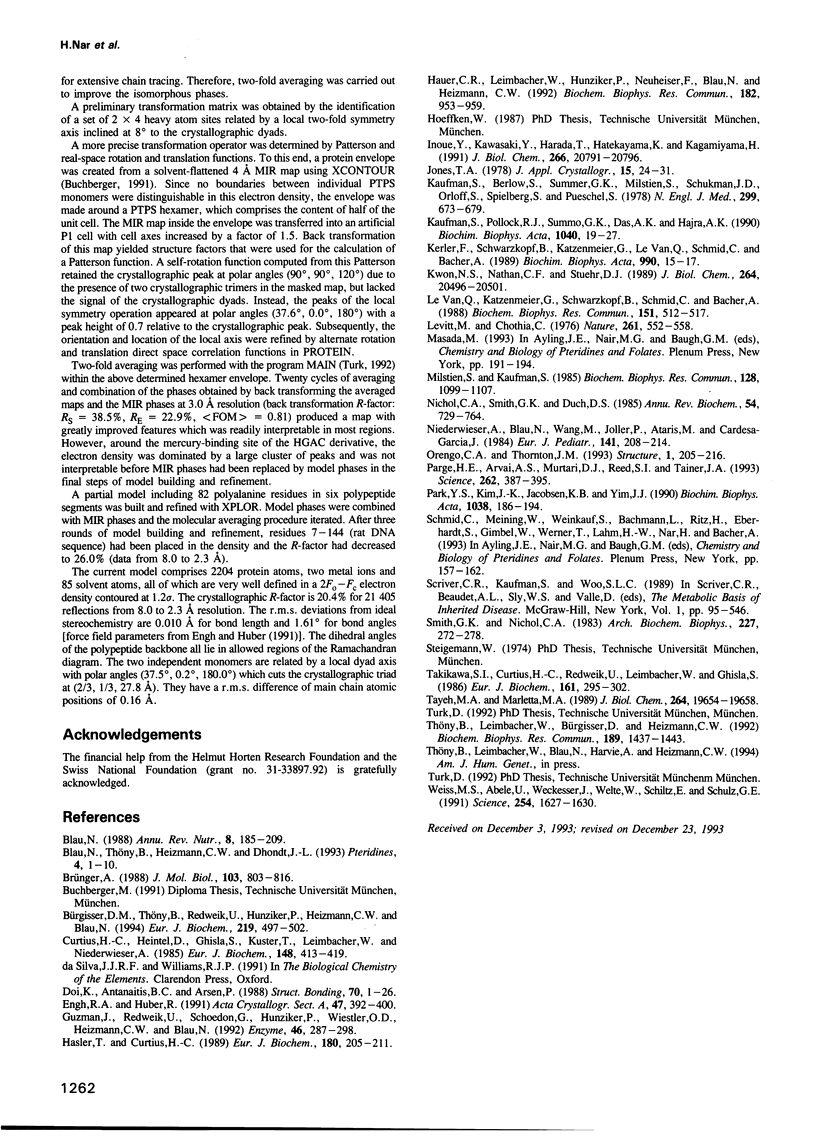
Images in this article
Selected References
These references are in PubMed. This may not be the complete list of references from this article.
- Blau N. Inborn errors of pterin metabolism. Annu Rev Nutr. 1988;8:185–209. doi: 10.1146/annurev.nu.08.070188.001153. [DOI] [PubMed] [Google Scholar]
- Borchert T. V., Abagyan R., Kishan K. V., Zeelen J. P., Wierenga R. K. The crystal structure of an engineered monomeric triosephosphate isomerase, monoTIM: the correct modelling of an eight-residue loop. Structure. 1993 Nov 15;1(3):205–213. doi: 10.1016/0969-2126(93)90021-8. [DOI] [PubMed] [Google Scholar]
- Bürgisser D. M., Thöny B., Redweik U., Hunziker P., Heizmann C. W., Blau N. Expression and characterization of recombinant human and rat liver 6-pyruvoyl tetrahydropterin synthase. Modified cysteine residues inhibit the enzyme activity. Eur J Biochem. 1994 Jan 15;219(1-2):497–502. doi: 10.1111/j.1432-1033.1994.tb19964.x. [DOI] [PubMed] [Google Scholar]
- Curtius H. C., Heintel D., Ghisla S., Kuster T., Leimbacher W., Niederwieser A. Tetrahydrobiopterin biosynthesis. Studies with specifically labeled (2H)NAD(P)H and 2H2O and of the enzymes involved. Eur J Biochem. 1985 May 2;148(3):413–419. doi: 10.1111/j.1432-1033.1985.tb08855.x. [DOI] [PubMed] [Google Scholar]
- Guzman J., Redweik U., Schoedon G., Hunziker P., Wiestler O. D., Heizmann C. W., Blau N. Purification and characterization of 6-pyruvoyl tetrahydropterin synthase from human pituitary gland. Enzyme. 1992;46(6):287–298. doi: 10.1159/000468806. [DOI] [PubMed] [Google Scholar]
- Hasler T., Curtius H. C. Purification and characterization of 6-pyruvoyl tetrahydropterin synthase from salmon liver. Eur J Biochem. 1989 Mar 1;180(1):205–211. doi: 10.1111/j.1432-1033.1989.tb14635.x. [DOI] [PubMed] [Google Scholar]
- Hauer C. R., Leimbacher W., Hunziker P., Neuheiser F., Blau N., Heizmann C. W. 6-pyruvoyl tetrahydropterin synthase from salmon liver: amino acid sequence analysis by tandem mass spectrometry. Biochem Biophys Res Commun. 1992 Jan 31;182(2):953–959. doi: 10.1016/0006-291x(92)91824-a. [DOI] [PubMed] [Google Scholar]
- Inoue Y., Kawasaki Y., Harada T., Hatakeyama K., Kagamiyama H. Purification and cDNA cloning of rat 6-pyruvoyl-tetrahydropterin synthase. J Biol Chem. 1991 Nov 5;266(31):20791–20796. [PubMed] [Google Scholar]
- Kaufman S., Berlow S., Summer G. K., Milstien S., Schulman J. D., Orloff S., Spielberg S., Pueschel S. Hyperphenylalaninemia due to a deficiency of biopterin. A variant form of phenylketonuria. N Engl J Med. 1978 Sep 28;299(13):673–679. doi: 10.1056/NEJM197809282991301. [DOI] [PubMed] [Google Scholar]
- Kaufman S., Pollock R. J., Summer G. K., Das A. K., Hajra A. K. Dependence of an alkyl glycol-ether monooxygenase activity upon tetrahydropterins. Biochim Biophys Acta. 1990 Aug 1;1040(1):19–27. doi: 10.1016/0167-4838(90)90141-2. [DOI] [PubMed] [Google Scholar]
- Kerler F., Schwarzkopf B., Katzenmaier G., Le Van Q., Schmid C., Ziegler I., Bacher A. Biosynthesis of tetrahydrobiopterin: a sensitive assay of 6-pyruvoyltetrahydropterin synthase using [2'-3H]dihydroneopterin 3'-triphosphate as substrate. Biochim Biophys Acta. 1989 Jan 27;990(1):15–17. doi: 10.1016/s0304-4165(89)80005-4. [DOI] [PubMed] [Google Scholar]
- Kwon N. S., Nathan C. F., Stuehr D. J. Reduced biopterin as a cofactor in the generation of nitrogen oxides by murine macrophages. J Biol Chem. 1989 Dec 5;264(34):20496–20501. [PubMed] [Google Scholar]
- Le Van Q., Katzenmeier G., Schwarzkopf B., Schmid C., Bacher A. Biosynthesis of biopterin. Studies on the mechanism of 6-pyruvoyltetrahydropteridine synthase. Biochem Biophys Res Commun. 1988 Feb 29;151(1):512–517. doi: 10.1016/0006-291x(88)90623-7. [DOI] [PubMed] [Google Scholar]
- Levitt M., Chothia C. Structural patterns in globular proteins. Nature. 1976 Jun 17;261(5561):552–558. doi: 10.1038/261552a0. [DOI] [PubMed] [Google Scholar]
- Milstien S., Kaufman S. Biosynthesis of tetrahydrobiopterin: conversion of dihydroneopterin triphosphate to tetrahydropterin intermediates. Biochem Biophys Res Commun. 1985 May 16;128(3):1099–1107. doi: 10.1016/0006-291x(85)91053-8. [DOI] [PubMed] [Google Scholar]
- Nichol C. A., Smith G. K., Duch D. S. Biosynthesis and metabolism of tetrahydrobiopterin and molybdopterin. Annu Rev Biochem. 1985;54:729–764. doi: 10.1146/annurev.bi.54.070185.003501. [DOI] [PubMed] [Google Scholar]
- Niederwieser A., Blau N., Wang M., Joller P., Atarés M., Cardesa-Garcia J. GTP cyclohydrolase I deficiency, a new enzyme defect causing hyperphenylalaninemia with neopterin, biopterin, dopamine, and serotonin deficiencies and muscular hypotonia. Eur J Pediatr. 1984 Feb;141(4):208–214. doi: 10.1007/BF00572762. [DOI] [PubMed] [Google Scholar]
- Parge H. E., Arvai A. S., Murtari D. J., Reed S. I., Tainer J. A. Human CksHs2 atomic structure: a role for its hexameric assembly in cell cycle control. Science. 1993 Oct 15;262(5132):387–395. doi: 10.1126/science.8211159. [DOI] [PubMed] [Google Scholar]
- Park Y. S., Kim J. H., Jacobson K. B., Yim J. J. Purification and characterization of 6-pyruvoyl-tetrahydropterin synthase from Drosophila melanogaster. Biochim Biophys Acta. 1990 Apr 19;1038(2):186–194. doi: 10.1016/0167-4838(90)90203-r. [DOI] [PubMed] [Google Scholar]
- Schmid C., Meining W., Weinkauf S., Bachmann L., Ritz H., Eberhardt S., Gimbel W., Werner T., Lahm H. W., Nar H. Studies on GTP cyclohydrolase I of Escherichia coli. Adv Exp Med Biol. 1993;338:157–162. doi: 10.1007/978-1-4615-2960-6_30. [DOI] [PubMed] [Google Scholar]
- Smith G. K., Nichol C. A. Tetrahydrobiopterin is synthesized by separate pathways from dihydroneopterin triphosphate and from sepiapterin in adrenal medulla preparations. Arch Biochem Biophys. 1983 Nov;227(1):272–278. doi: 10.1016/0003-9861(83)90371-5. [DOI] [PubMed] [Google Scholar]
- Takikawa S., Curtius H. C., Redweik U., Leimbacher W., Ghisla S. Biosynthesis of tetrahydrobiopterin. Purification and characterization of 6-pyruvoyl-tetrahydropterin synthase from human liver. Eur J Biochem. 1986 Dec 1;161(2):295–302. doi: 10.1111/j.1432-1033.1986.tb10446.x. [DOI] [PubMed] [Google Scholar]
- Tayeh M. A., Marletta M. A. Macrophage oxidation of L-arginine to nitric oxide, nitrite, and nitrate. Tetrahydrobiopterin is required as a cofactor. J Biol Chem. 1989 Nov 25;264(33):19654–19658. [PubMed] [Google Scholar]
- Thöny B., Leimbacher W., Bürgisser D., Heizmann C. W. Human 6-pyruvoyltetrahydropterin synthase: cDNA cloning and heterologous expression of the recombinant enzyme. Biochem Biophys Res Commun. 1992 Dec 30;189(3):1437–1443. doi: 10.1016/0006-291x(92)90235-d. [DOI] [PubMed] [Google Scholar]
- Weiss M. S., Abele U., Weckesser J., Welte W., Schiltz E., Schulz G. E. Molecular architecture and electrostatic properties of a bacterial porin. Science. 1991 Dec 13;254(5038):1627–1630. doi: 10.1126/science.1721242. [DOI] [PubMed] [Google Scholar]






